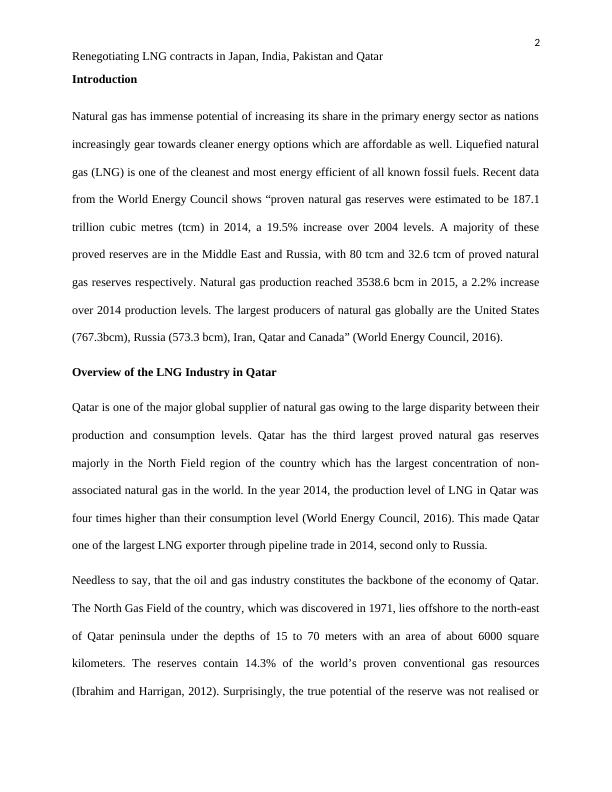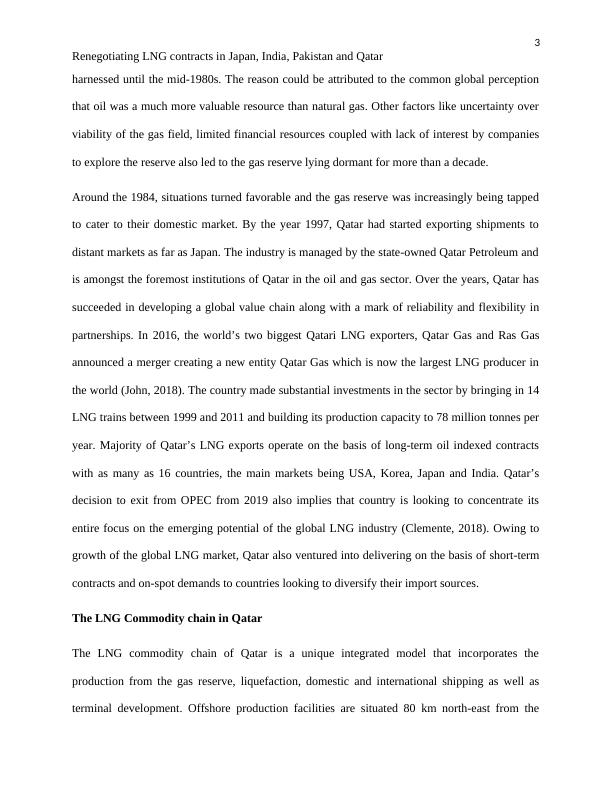Renegotiating LNG contracts in Japan, India, Pakistan and Qatar
Added on 2023-04-25
8 Pages2549 Words297 Views
1
Renegotiating LNG contracts in Japan, India, Pakistan and Qatar
Renegotiating LNG contracts in Japan, India,
Pakistan and Qatar
Renegotiating LNG contracts in Japan, India, Pakistan and Qatar
Renegotiating LNG contracts in Japan, India,
Pakistan and Qatar

2
Renegotiating LNG contracts in Japan, India, Pakistan and Qatar
Introduction
Natural gas has immense potential of increasing its share in the primary energy sector as nations
increasingly gear towards cleaner energy options which are affordable as well. Liquefied natural
gas (LNG) is one of the cleanest and most energy efficient of all known fossil fuels. Recent data
from the World Energy Council shows “proven natural gas reserves were estimated to be 187.1
trillion cubic metres (tcm) in 2014, a 19.5% increase over 2004 levels. A majority of these
proved reserves are in the Middle East and Russia, with 80 tcm and 32.6 tcm of proved natural
gas reserves respectively. Natural gas production reached 3538.6 bcm in 2015, a 2.2% increase
over 2014 production levels. The largest producers of natural gas globally are the United States
(767.3bcm), Russia (573.3 bcm), Iran, Qatar and Canada” (World Energy Council, 2016).
Overview of the LNG Industry in Qatar
Qatar is one of the major global supplier of natural gas owing to the large disparity between their
production and consumption levels. Qatar has the third largest proved natural gas reserves
majorly in the North Field region of the country which has the largest concentration of non-
associated natural gas in the world. In the year 2014, the production level of LNG in Qatar was
four times higher than their consumption level (World Energy Council, 2016). This made Qatar
one of the largest LNG exporter through pipeline trade in 2014, second only to Russia.
Needless to say, that the oil and gas industry constitutes the backbone of the economy of Qatar.
The North Gas Field of the country, which was discovered in 1971, lies offshore to the north-east
of Qatar peninsula under the depths of 15 to 70 meters with an area of about 6000 square
kilometers. The reserves contain 14.3% of the world’s proven conventional gas resources
(Ibrahim and Harrigan, 2012). Surprisingly, the true potential of the reserve was not realised or
Renegotiating LNG contracts in Japan, India, Pakistan and Qatar
Introduction
Natural gas has immense potential of increasing its share in the primary energy sector as nations
increasingly gear towards cleaner energy options which are affordable as well. Liquefied natural
gas (LNG) is one of the cleanest and most energy efficient of all known fossil fuels. Recent data
from the World Energy Council shows “proven natural gas reserves were estimated to be 187.1
trillion cubic metres (tcm) in 2014, a 19.5% increase over 2004 levels. A majority of these
proved reserves are in the Middle East and Russia, with 80 tcm and 32.6 tcm of proved natural
gas reserves respectively. Natural gas production reached 3538.6 bcm in 2015, a 2.2% increase
over 2014 production levels. The largest producers of natural gas globally are the United States
(767.3bcm), Russia (573.3 bcm), Iran, Qatar and Canada” (World Energy Council, 2016).
Overview of the LNG Industry in Qatar
Qatar is one of the major global supplier of natural gas owing to the large disparity between their
production and consumption levels. Qatar has the third largest proved natural gas reserves
majorly in the North Field region of the country which has the largest concentration of non-
associated natural gas in the world. In the year 2014, the production level of LNG in Qatar was
four times higher than their consumption level (World Energy Council, 2016). This made Qatar
one of the largest LNG exporter through pipeline trade in 2014, second only to Russia.
Needless to say, that the oil and gas industry constitutes the backbone of the economy of Qatar.
The North Gas Field of the country, which was discovered in 1971, lies offshore to the north-east
of Qatar peninsula under the depths of 15 to 70 meters with an area of about 6000 square
kilometers. The reserves contain 14.3% of the world’s proven conventional gas resources
(Ibrahim and Harrigan, 2012). Surprisingly, the true potential of the reserve was not realised or

3
Renegotiating LNG contracts in Japan, India, Pakistan and Qatar
harnessed until the mid-1980s. The reason could be attributed to the common global perception
that oil was a much more valuable resource than natural gas. Other factors like uncertainty over
viability of the gas field, limited financial resources coupled with lack of interest by companies
to explore the reserve also led to the gas reserve lying dormant for more than a decade.
Around the 1984, situations turned favorable and the gas reserve was increasingly being tapped
to cater to their domestic market. By the year 1997, Qatar had started exporting shipments to
distant markets as far as Japan. The industry is managed by the state-owned Qatar Petroleum and
is amongst the foremost institutions of Qatar in the oil and gas sector. Over the years, Qatar has
succeeded in developing a global value chain along with a mark of reliability and flexibility in
partnerships. In 2016, the world’s two biggest Qatari LNG exporters, Qatar Gas and Ras Gas
announced a merger creating a new entity Qatar Gas which is now the largest LNG producer in
the world (John, 2018). The country made substantial investments in the sector by bringing in 14
LNG trains between 1999 and 2011 and building its production capacity to 78 million tonnes per
year. Majority of Qatar’s LNG exports operate on the basis of long-term oil indexed contracts
with as many as 16 countries, the main markets being USA, Korea, Japan and India. Qatar’s
decision to exit from OPEC from 2019 also implies that country is looking to concentrate its
entire focus on the emerging potential of the global LNG industry (Clemente, 2018). Owing to
growth of the global LNG market, Qatar also ventured into delivering on the basis of short-term
contracts and on-spot demands to countries looking to diversify their import sources.
The LNG Commodity chain in Qatar
The LNG commodity chain of Qatar is a unique integrated model that incorporates the
production from the gas reserve, liquefaction, domestic and international shipping as well as
terminal development. Offshore production facilities are situated 80 km north-east from the
Renegotiating LNG contracts in Japan, India, Pakistan and Qatar
harnessed until the mid-1980s. The reason could be attributed to the common global perception
that oil was a much more valuable resource than natural gas. Other factors like uncertainty over
viability of the gas field, limited financial resources coupled with lack of interest by companies
to explore the reserve also led to the gas reserve lying dormant for more than a decade.
Around the 1984, situations turned favorable and the gas reserve was increasingly being tapped
to cater to their domestic market. By the year 1997, Qatar had started exporting shipments to
distant markets as far as Japan. The industry is managed by the state-owned Qatar Petroleum and
is amongst the foremost institutions of Qatar in the oil and gas sector. Over the years, Qatar has
succeeded in developing a global value chain along with a mark of reliability and flexibility in
partnerships. In 2016, the world’s two biggest Qatari LNG exporters, Qatar Gas and Ras Gas
announced a merger creating a new entity Qatar Gas which is now the largest LNG producer in
the world (John, 2018). The country made substantial investments in the sector by bringing in 14
LNG trains between 1999 and 2011 and building its production capacity to 78 million tonnes per
year. Majority of Qatar’s LNG exports operate on the basis of long-term oil indexed contracts
with as many as 16 countries, the main markets being USA, Korea, Japan and India. Qatar’s
decision to exit from OPEC from 2019 also implies that country is looking to concentrate its
entire focus on the emerging potential of the global LNG industry (Clemente, 2018). Owing to
growth of the global LNG market, Qatar also ventured into delivering on the basis of short-term
contracts and on-spot demands to countries looking to diversify their import sources.
The LNG Commodity chain in Qatar
The LNG commodity chain of Qatar is a unique integrated model that incorporates the
production from the gas reserve, liquefaction, domestic and international shipping as well as
terminal development. Offshore production facilities are situated 80 km north-east from the

End of preview
Want to access all the pages? Upload your documents or become a member.
Related Documents
Mission and Vision of RasGaslg...
|9
|1855
|189
HI5003 - Economics - Demand and Supply of LNG in Australialg...
|7
|1463
|43
Global Dimensions of ExxonMobil Corporationlg...
|6
|1461
|132
